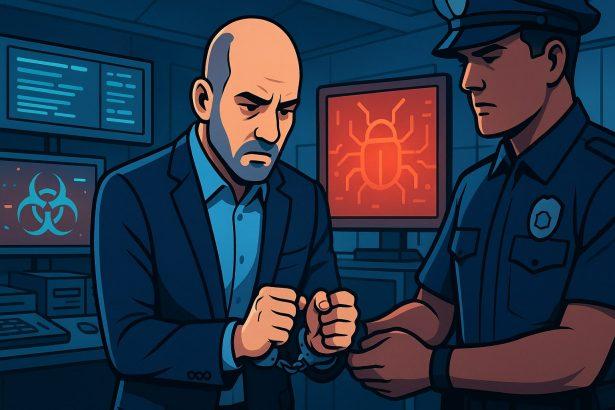A trusted cybersecurity leader. A hospital network in crisis. A digital betrayal that few saw coming.
In a case that is as surreal as it is alarming, the CEO of a cybersecurity firm has been arrested for allegedly installing malware on the very hospital computers he was hired to protect. As investigators dig deeper, this story underscores a growing threat in the digital age: the insider with keys to the kingdom.
A Stunning Fall From Grace
The arrest, reported by EnigmaSoft, details a scenario pulled straight from a thriller—except it’s disturbingly real.
The unnamed executive, responsible for securing hospital networks, is now accused of weaponizing his access to deploy malicious code. The malware, stealthily installed across hospital devices, was allegedly designed to extract patient records, financial data, and possibly manipulate system operations.
For patients and staff, the betrayal is gut-wrenching. For the cybersecurity industry, it’s a nightmare scenario that threatens to erode the fragile trust upon which it’s built.
How the Alleged Attack Was Carried Out
This wasn’t a remote breach by overseas hackers. It was an internal exploitation of trust and privilege. Here’s how the scheme allegedly unfolded:
- Access Through Contract: The cybersecurity firm was contracted by the hospital to provide protection and IT monitoring.
- Malware Disguised as Updates: The CEO allegedly pushed software updates laced with malware—hiding malicious code within legitimate installations.
- Data Theft and Backdoor Creation: Once inside, the malware could capture patient data, including medical histories and billing information, while potentially leaving behind backdoors for future exploits.
According to digital forensic experts, the attack was difficult to detect precisely because of the trust granted to the attacker.
Who’s at Risk?
The immediate victims are the hospital system’s staff and patients. But the scope of the impact could ripple far beyond:
- Patients: Exposed personal and medical data opens the door to identity theft, fraud, and extortion.
- Healthcare Workers: Compromised login credentials and internal communications may be misused.
- Healthcare Institutions: The breach puts regulatory compliance, funding, and operational continuity at risk.
- Cybersecurity Industry: Trust in service providers—especially smaller or less-regulated firms—has taken a hit.
Why This Is a Wake-Up Call
What makes this case chilling isn’t just the breach itself—it’s what it represents: a growing wave of insider-driven attacks. Unlike external threats, insider attacks often come from individuals who already have elevated access, knowledge of system architecture, and, critically, the institution’s trust.
Insider threats have increased sharply in recent years. According to IBM’s 2024 Cost of a Data Breach Report, insider incidents now make up nearly a quarter of all security breaches.
Fallout and Repercussions
The financial, operational, and psychological costs of this breach are enormous:
- Regulatory Scrutiny: The hospital could face investigations under HIPAA and other data protection laws.
- Reputation Damage: Patients may lose trust in the hospital’s ability to safeguard their data.
- Litigation Risks: Affected patients and staff could pursue legal action for negligence and damages.
- Industry Oversight: The cybersecurity firm, now disgraced, could be subject to criminal prosecution, fines, and permanent blacklisting.
More broadly, this case may spark new compliance measures, including stricter vendor oversight, continuous behavioral monitoring, and tighter access control standards across the healthcare sector.
Reactions from the Cybersecurity Community
Security professionals have reacted with shock and outrage.
Allan Vega, a former security consultant for major hospital systems, commented:
“This isn’t just a technical failure—it’s an ethical collapse. It proves that cybersecurity is as much about character as it is about code.”
Meanwhile, CSO Online reports that more healthcare institutions are shifting to zero-trust security architectures, where no user is inherently trusted, even those with high-level access.
How to Protect Against Insider Threats
For Organizations:
- Adopt Zero-Trust Frameworks: Assume breach and validate continuously.
- Monitor Activity Logs: Even trusted users should be under behavioral observation.
- Segment Network Access: Don’t give vendors unrestricted entry to entire systems.
- Update Contracts: Require cybersecurity vendors to submit to external audits.
For Individuals:
- Stay Alert: Monitor credit reports and medical bills for strange activity.
- Use Identity Protection Services: Many offer healthcare fraud detection.
- Report Suspicious Emails or Calls: Scammers often follow breaches with phishing attempts.
What Comes Next?
The suspect awaits trial, but the consequences of this case are already unfolding across the cybersecurity landscape. In the coming months, experts predict:
- Federal Oversight Expansion: Legislation may follow, demanding tighter controls for vendors in healthcare.
- Stronger Breach Notification Laws: Timelines for reporting may be shortened to reduce risk exposure.
- AI-Powered Security: Companies will likely increase adoption of machine-learning models that detect insider anomalies in real time.
A broader cultural shift may also be underway, moving from “trust and delegate” to “verify and contain”—even when dealing with partners.
Final Thoughts: A Cautionary Tale in the Digital Age
This story is more than a scandal. It’s a parable for a digital era where data is currency, and trust can be exploited as a weapon.
If a cybersecurity executive can turn predator, it begs the question: Who watches the watchers?
In a world of increasing cyber complexity, the answer must be all of us—armed with awareness, accountability, and the tools to protect the systems we rely on.




